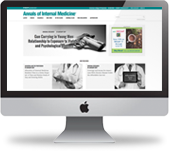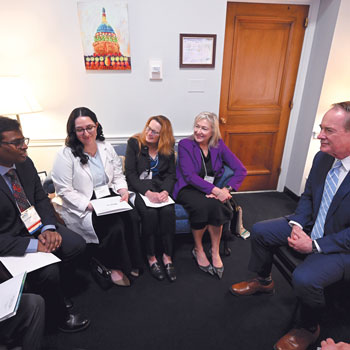Build your career into your job description
Physicians should try out strategies to prioritize career-advancing projects, even when day-to-day tasks are keeping them too busy.
Have you been letting your job get in the way of your career?
Chris Sankey, MD, FACP, offered some examples of how this might occur at any point in a physician's career, including early on.

“Do you have projects that were either abandoned or not started, grants or manuscripts that weren't written, skill-building opportunities skipped, important relationships—mentor, sponsor, coach—not maintained?” he asked. “Or, ‘I wanted to go to that conference, but I just had too much to do’?”
For those who did make it to Converge 2025, the annual meeting of the Society of Hospital Medicine, held in Las Vegas in April, Dr. Sankey offered advice on how to prioritize career-advancing projects even when day-to-day tasks (i.e., your job) are keeping you too busy.
“What can we accomplish if we're more effective in tending to our careers?” asked Dr. Sankey, a hospitalist and associate professor at Yale School of Medicine in New Haven, Conn. His potential answers included wellness, satisfaction, promotion opportunities, and sense of purpose.
“It's easy to drift a little bit away from the passions and the values that really led you into the profession,” he said.
It's also easy to conflate the urgency of a task with its importance. Dr. Sankey credited President Dwight D. Eisenhower with his preferred method of categorizing a to-do list into four quadrants: urgent and important, nonurgent but important, urgent but unimportant, and nonurgent and unimportant.
Tasks to advance your career likely fall into the second category, but it's easy for them to get preempted by things in the other categories, even the fourth, which includes some activities that everyone knows detract from their efficiency, such as social media.
“We probably all scroll through the video of the fox that ran through our sister's friend's yard last night,” Dr. Sankey said. “This can be a helpful rubric to think about how it is we're apportioning our time.”
Once you've analyzed how your time is spent, the next step is to take some control over it. Dr. Sankey offered a selection of the “high- yield” efficiency strategies he's collected over time, beginning with reclaiming your calendar.
“I found this to be super important as calendars have gotten more and more transparent,” he said. “Has anybody gotten that meeting request, ‘Oh, I'm looking at your calendar and I'm seeing that you're available at such and such a time’? I have students that can actually schedule themselves with me without asking.”
Whether your calendar is controlled by the world at large, an administrative assistant, or just you, it can be scheduled with more mindfulness of career priorities. “The calendar can be a really, really powerful way to both map and prioritize time for us to do the things that are really meaningful,” said Dr. Sankey.
If you want some time to think about an upcoming grant application or article submission, block it off on your calendar. “I challenge you to schedule this quadrant of career-sustaining, important, nonurgent time for one hour per week and do that for a month,” he said. “If that feels like a heavy lift, do half an hour and then reassess.”
How do you decide what tasks fit in that category? Dr. Sankey writes down everything he has to do, categorizing each into one of those four quadrants on a worksheet (or sheets). “I needed three pages for quadrant three,” which contains urgent but unimportant to-dos, he said. “I felt like that was an important signal to me that perhaps my job was encroaching on my career.”
Of course, to some extent, your job is entitled to encroach on your career, but distractors are not, and they were Dr. Sankey's next target. “I'm not talking about distractions. Distractions can be things or people that have other motives. Distractors are typically electronic entities whose sole purpose for existing is to get your attention,” he said.
Studies have quantified the impact of these distractors, finding that it takes between one and three minutes to refocus on a task after being distracted. “How often do we get these distractors?” asked Dr. Sankey. “Last week, I averaged 103 notifications a day. So, a lot.”
His solution is to modify your smartphone settings, including turning off email notifications. “I'd be seeing patients on the wards, and my hip would ding. I'd come out of the room and look, and there was one email message. I open it right there in the middle of the hallway, and it's like ‘Are all of your pipetting needs being met?’” said Dr. Sankey, to laughter from the audience. “The best thing I ever did was just to turn off that stupid notification.”
Other potentially useful settings include time limits on specific apps and focus modes, which can be set to only let certain contacts trigger notifications. “My kids' day care could get through, but my college roommate doesn't necessarily have to,” he explained.
Dr. Sankey recommended trying these setting changes for a week, with the goal of reducing smartphone use by 1% to 5%. “What happens? Does the world fall apart? If it does, you can turn it back on,” he said.
He also offered some additional tips on increasing your efficiency in managing email beyond turning off notifications. The process starts with checking for email less frequently, no more than once an hour. “It's hard, but it's like training for a 5K. The more you do it, the easier it becomes,” said Dr. Sankey.
He's also a fan of the zero-inbox strategy, recommending that physicians delete or file every email after one reading.
Another secret to spending less time on email is to send fewer of them, especially to excess recipients, Dr. Sankey advised. “How many times do we get cc’ed on an email that has 17 people on it and says something like ‘Thanks'?” he said. “The more you cc other people, typically the more unhelpful email you're going to get.”
When you do send emails, consider making sure they go out during normal hours, Dr. Sankey recommended. He prefers scheduled send over a signature line that says it's not necessary to reply during off-hours, especially if you're emailing someone you outrank.
“When you are navigating a power gradient, actions still speak louder than words,” he said. “The other reason is that, just like the cc’ing, it functionally backfires on us. … It's 10 p.m. I'm trying to get through my to-do list. I send the email, and I'm like, ‘Ah, I'm done.’ And then what happens? The person emails you back.”
Dr. Sankey's final advice, conveyed with the help of a big red button, was to say no. “Easy to say, harder to do, but really, really important, especially when we're trying to toggle between our jobs and our careers,” he said.
One strategy is to think about the future yeses you are enabling with your current answer. “If I say no to this, does that mean I'm saying yes to something else? And is that yes perhaps more aligned with my needs and my goals?” he said. “You can flip it around.”
It can also be easier to say no if you make it clear that your response applies only to the specific request, not the person asking. “I'm not saying no to you. I'm saying no to this role or this task,” said Dr. Sankey.
Finally, taking your time giving an answer may make it easier to say no. “When we say yes, we often say that really fast, right?” said Dr. Sankey. “If we can think … ‘I was curious about the request, I asked questions, I got answers to them, and now I know it's a no.’”
He urged physicians, especially those early in their careers, to try out these strategies to make time for their own priorities. “I just come across so many colleagues and friends and mentees and sponsees who feel like any time they get asked anything, the answer always has to be yes,” he said, “and I just don't think that is the case.”




